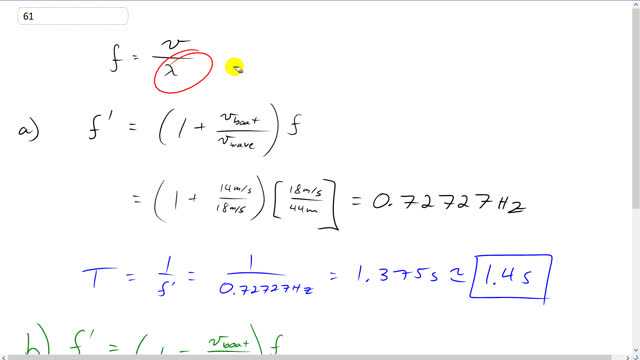
A wave on the ocean surface with wavelength 44 m travels east at a speed of 18 m/s relative to the ocean floor. If, on this stretch of ocean, a powerboat is moving at 14 m/s (relative to the ocean floor), how often does the boat encounter a wave crest, if the boat is traveling
- west, and
- east?

In order to watch this solution you need to have a subscription.
This is Giancoli Answers with Mr. Dychko. The person measuring the wavelength of these water waves that's reported in the question must be at rest with respect to the ground in order to make these measurements of λ. And so the frequency we calculate from this λ of 44 meters is going to be the frequency of a stationary sound source. Or say stationary wave source you could say. So, f prime, the frequency measured by the boat that's moving is going to be calculated by the Doppler formula for a moving observer going towards a stationary sound source. But it's not sound anymore, it's water waves. And so instead of the speed of sound here, we're gonna use speed of the wave with respect to ground. And here's the speed of the boat with respect to ground. So, the time between wave crests is going to be the reciprocal of this f prime. And f prime v1 plus speed of the boat divided by speed of the wave times this stationary frequency of the waves. And that's going to be 1 plus 14 meters per second over 18 meters per second times the speed of the wave, 18, divided by its wavelength, 44. And that gives 0.7277 hertz. And then take the reciprocal that and you get about 1.4 seconds as the time between wave crests. Now, when the boat is moving the same direction as the waves, it's like an observer moving away from a stationary source. So, that's 1 minus speed of the boat over speed of the waves times the frequency. So, it's 1 minus 14 over 18 times 18 over 44. Then the reciprocal of this 0.09 hertz is going to be about 11 seconds between wave crests.